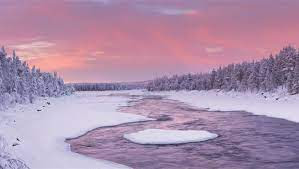Artic Region
"The Arctic Tundra: A Delicate Ecosystem in Peril"
The "Arctic region" refers to the northernmost part of the Earth, surrounding the North Pole. It is characterized by its cold climate, unique ecosystems, and vast expanses of ice and snow. The Arctic Circle, an imaginary line at approximately 66.5 degrees north latitude, marks the southern boundary of this region. The Arctic is a distinct and important area with its own environmental and geopolitical significance.
Key features of the Arctic region include:
Climate: The Arctic climate is characterized by extremely cold temperatures, especially during the long winter months when polar nights prevail. Summers are short and relatively cool. The Arctic experiences significant seasonal variations in daylight due to the tilt of the Earth's axis.

The "Arctic region" refers to the northernmost part of the Earth, surrounding the North Pole. It is characterized by its cold climate, unique ecosystems, and vast expanses of ice and snow. The Arctic Circle, an imaginary line at approximately 66.5 degrees north latitude, marks the southern boundary of this region. The Arctic is a distinct and important area with its own environmental and geopolitical significance.
Key features of the Arctic region include:
Climate: The Arctic climate is characterized by extremely cold temperatures, especially during the long winter months when polar nights prevail. Summers are short and relatively cool. The Arctic experiences significant seasonal variations in daylight due to the tilt of the Earth's axis.

Sea Ice: The Arctic Ocean is covered by a layer of sea ice that forms during the winter and partially melts during the summer months. The extent of sea ice varies seasonally, with minimum ice cover typically occurring in September and maximum ice cover around March.
Arctic Tundra: The dominant terrestrial ecosystem in the Arctic is the tundra, which consists of treeless plains covered in mosses, lichens, and low-lying shrubs. The short growing season and permafrost (permanently frozen ground) limit the types of plants that can survive in this environment.
Wildlife: The Arctic region is home to a variety of unique animal species, including polar bears, Arctic foxes, caribou (reindeer), muskoxen, walruses, and various bird species. Marine mammals such as seals, whales, and narwhals are also common in Arctic waters.
Indigenous Peoples: Several indigenous communities have lived in the Arctic for thousands of years, including the Inuit, Yupik, and Saami. These communities have adapted their way of life to the harsh Arctic conditions and have a deep understanding of the region's ecosystems.
Climate Change: The Arctic is particularly vulnerable to the effects of climate change, with temperatures rising at a faster rate than in other parts of the world. The reduction in sea ice cover and thawing permafrost have significant implications for the region's ecosystems and contribute to global sea level rise.
Geopolitical Importance: The Arctic's strategic location and abundance of natural resources, such as oil, gas, and minerals, have led to increased attention from various countries and industries. The Arctic region is subject to territorial disputes and geopolitical tensions as nations seek to assert their interests in the area.
The Arctic region plays a crucial role in the Earth's climate system and has global implications for weather patterns, ocean currents, and sea level rise. As such, it is a focus of scientific research, conservation efforts, and international cooperation to address the challenges posed by climate change and environmental issues.
Visit: https://bestpaperaward.blogspot.com/
#ArcticRegion
#ArcticCircle
#PolarRegion
#ArcticClimate
#ArcticWildlife
#ArcticTundra
#ArcticExploration
#ArcticEnvironment
#ArcticConservation
#ArcticResearch
#ArcticEcosystem
#ArcticAdventures
#ArcticExplorers
#ArcticCulture
#ArcticScience
#ArcticCommunity
#ArcticWilderness
#ArcticNature
#ArcticGeography
#ArcticTravel
Facebook: https://www.facebook.com/profile.phpid=100087106114908
Twitter : https://twitter.com/bestpaperaward
Pinterest : https://in.pinterest.com/bestpaperaward
Linkedin : https://www.linkedin.com/in/esha-gupta-18b2b4245
Instagram: https://www.instagram.com/eshagupta__2022/
Arctic Tundra: The dominant terrestrial ecosystem in the Arctic is the tundra, which consists of treeless plains covered in mosses, lichens, and low-lying shrubs. The short growing season and permafrost (permanently frozen ground) limit the types of plants that can survive in this environment.
Wildlife: The Arctic region is home to a variety of unique animal species, including polar bears, Arctic foxes, caribou (reindeer), muskoxen, walruses, and various bird species. Marine mammals such as seals, whales, and narwhals are also common in Arctic waters.
Indigenous Peoples: Several indigenous communities have lived in the Arctic for thousands of years, including the Inuit, Yupik, and Saami. These communities have adapted their way of life to the harsh Arctic conditions and have a deep understanding of the region's ecosystems.
Climate Change: The Arctic is particularly vulnerable to the effects of climate change, with temperatures rising at a faster rate than in other parts of the world. The reduction in sea ice cover and thawing permafrost have significant implications for the region's ecosystems and contribute to global sea level rise.
Geopolitical Importance: The Arctic's strategic location and abundance of natural resources, such as oil, gas, and minerals, have led to increased attention from various countries and industries. The Arctic region is subject to territorial disputes and geopolitical tensions as nations seek to assert their interests in the area.
The Arctic region plays a crucial role in the Earth's climate system and has global implications for weather patterns, ocean currents, and sea level rise. As such, it is a focus of scientific research, conservation efforts, and international cooperation to address the challenges posed by climate change and environmental issues.
Visit: https://bestpaperaward.blogspot.com/
#ArcticRegion
#ArcticCircle
#PolarRegion
#ArcticClimate
#ArcticWildlife
#ArcticTundra
#ArcticExploration
#ArcticEnvironment
#ArcticConservation
#ArcticResearch
#ArcticEcosystem
#ArcticAdventures
#ArcticExplorers
#ArcticCulture
#ArcticScience
#ArcticCommunity
#ArcticWilderness
#ArcticNature
#ArcticGeography
#ArcticTravel
Facebook: https://www.facebook.com/profile.phpid=100087106114908
Twitter : https://twitter.com/bestpaperaward
Pinterest : https://in.pinterest.com/bestpaperaward
Linkedin : https://www.linkedin.com/in/esha-gupta-18b2b4245
Instagram: https://www.instagram.com/eshagupta__2022/



Comments
Post a Comment